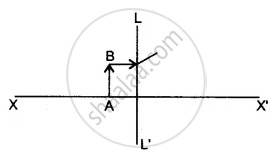Advertisements
Advertisements
प्रश्न
An object of height 4.25 mm is placed at a distance of 10 cm from a convex lens of power +5D. Find (i) the focal length of the lens, and (ii) the size of the image.
उत्तर
Object height, h = 4.25 mm = 0.425 cm (1 cm = 10 mm)
Object distance, u =-10 cm
Power, P = +5 D
Focal length, f = ?
Image distance, v = ?
Image height, h' = ?
Power, P
Using the lens formula, we get:
∴ v=-20cm
Now, magnification, m =
Substituting the values in the above equation, we get:
Thus, the image is 8.5 mm long; it is also erect and virtual.
APPEARS IN
संबंधित प्रश्न
A doctor has prescribed a corrective lens of power +1.5 D. Find the focal length of the lens. Is the prescribed lens diverging or converging?
Consider two statements A and B given below:
A: real image is always inverted
B: virtual image is always erect
Out of these two statements:
A doctor has prescribed a corrective lens of power, −1.5 D. Find the focal length of the lens. Is the prescribed lens diverging or converging?
An object of height 4 cm is placed at a distance of 15 cm in front of a concave lens of power, −10 dioptres. Find the size of the image.
The power of a combination of two lenses X and Y is 5 D. If the focal length of lens X be 15 cm :
(a) calculate the focal length of lens Y.
(b) state the nature of lens Y.
Two lenses A and B have focal lengths of +20 cm and, −10 cm, respectively.
(a) What is the nature of lens A and lens B?
(b) What is the power of lens A and lens B?
(c) What is the power of combination if lenses A and B are held close together?
What is the unit of power of a lens? Define the unit of power of a lens.
What is meant by the power of accommodation produced?
Complete the diagram to show the formation of the image of the object AB.

(i) Name the Lens LL’.
(ii) Where is the image of the object AB formed?
(iii) State three characteristics of the image.
The focal length of a double convex lens is equal to the radius of curvature of either surface. What is the refractive index of its material?
